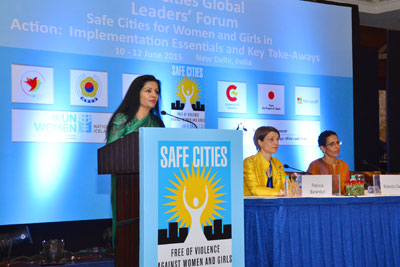No city can be smart and sustainable if half of its population is not safe and lives in fear of violence. – Lakshmi Puri
Opening remarks delivered on 10 June, by UN Women Deputy Executive Director, Lakshmi Puri, at the Safe Cities Global Stakeholders’ Planning Meeting “Safe Cities for Women and Girls – Implementation Essentials”, held in New Delhi, India from 10 – 12 June.Date:

Esteemed guests on the dais;
Friends from the media;
Colleagues;
Ladies and gentlemen,
Thank you for joining us. In today’s increasingly urban world, providing safe living environments, productive economies and equitable social benefits are challenges facing towns and cities globally.
In the early nineties the percentage of people living in urban areas was 42.9 per cent, in 2015 it is 54 per cent, and in 2030, it is expected to be 60 per cent. Within urban population, there is an increasing cluster of large cities underway, in particular those with more than 5 million people. This transformational process is being particularly felt among the Least Developed Countries.
How does all this affect women? From transport to access to information, to safe housing, it impacts them every day! Ensuring basic services to an increasing amount of people is a challenge, in particular for those women and girls living in poverty or marginalized groups.
Urban safety is intrinsically linked to the concept of the Right to the City, and encompasses every person’s rights to mobility and access social, economic, political, cultural opportunities that the cities offer. Adequate gender-sensitive planning in the provision of services and infrastructure can become an empowerment force that enables the full enjoyment of women to their right to public space, gender equality, and equal access to income, education, health care, justice, and political participation and influence.
Yet, sexual violence in public spaces remains a universal concern. Women in every city in the world, without exception, in developing and developed countries, face sexual harassment and other forms of violence in public spaces. But few cities are courageous enough to hold themselves accountable and undertake actions to comprehensively address it.
The cities that are part of UN Women’s flagship Safe Cities Global Initiative are pioneers, and an example for other cities to follow. This programme began in in five pilot cities and now spans 20 cities in both developing and developed countries. Some of the major cities include New Delhi, Cairo, Dublin, Rio de Janeiro, Reykjavik, Marrakech, Sakai in Japan, Quito, Port Moresby, Mexico City, Metro Manila, and Kigali among others.
UN Women’s ultimate goal with this programme is to ensure that women and girls in every city in the world are socially, economically and politically empowered in public spaces, which are free from all forms of violence.
This is key to achieving gender equality by 2030, which is one of the proposed Sustainable Development Goals, or SDGs. There are also other gender equality sensitive targets in the other proposed SDGs. The SDGs are a new, universal set of goals, targets and indicators that UN member states are defining to frame their agendas and political policies over the next 15 years. And SDG 11 is on safe and sustainable cities aligned with dignity, justice, people, planet, prosperity and partnership, is the foundation of such new development framework.
Around the world cities are being redesigned to meet the needs of sustainable development for all. No city can be smart and sustainable if half of its population is not safe and lives in fear of violence. Cities in India constitute a microcosm and macrocosm of that given their size, scale and scope. Safe Cities for women and girls must therefore be part of this new urbanization movement and made part of its DNA.
In this context, UN Women’s call for ‘Planet 50-50 by 2030 - Step it up for gender equality’ has been endorsed by international community as seen in the adoption of the recent CSW59’s Political Declaration.
We would like to urge all the leaders who come to the Global Safe Cities Forum to be a part of this effort for the years to come.
And the role of local leadership in achieving the SDGs is critical. Most of these goals be decided at the local municipal level and therefore the SDGs must be the basis of a change that is locally relevant, locally owned and locally sustainable.
In this context, India’s 100 Smart Cities Project, which will be launched by Prime Minister Narendra Modi this month, might provide a valuable and constructive way forward. We hope that this Smart Cities Project will fully integrate the perspectives of women and girls and be truly inclusive. And as the various states prepare to nominate their candidate cities, we hope that women’s safety will figure prominently in their proposals.
Let me conclude by calling on all stakeholders – governments, citizens, companies, and the media – to come together and make safe urban spaces for women a reality. I call on men and boys in particular to become champions for gender equality, women’s empowerment and ending violence against women. Take a stand, show us your support by joining our global HeForShe campaign at heforshe.org!
Thank you!